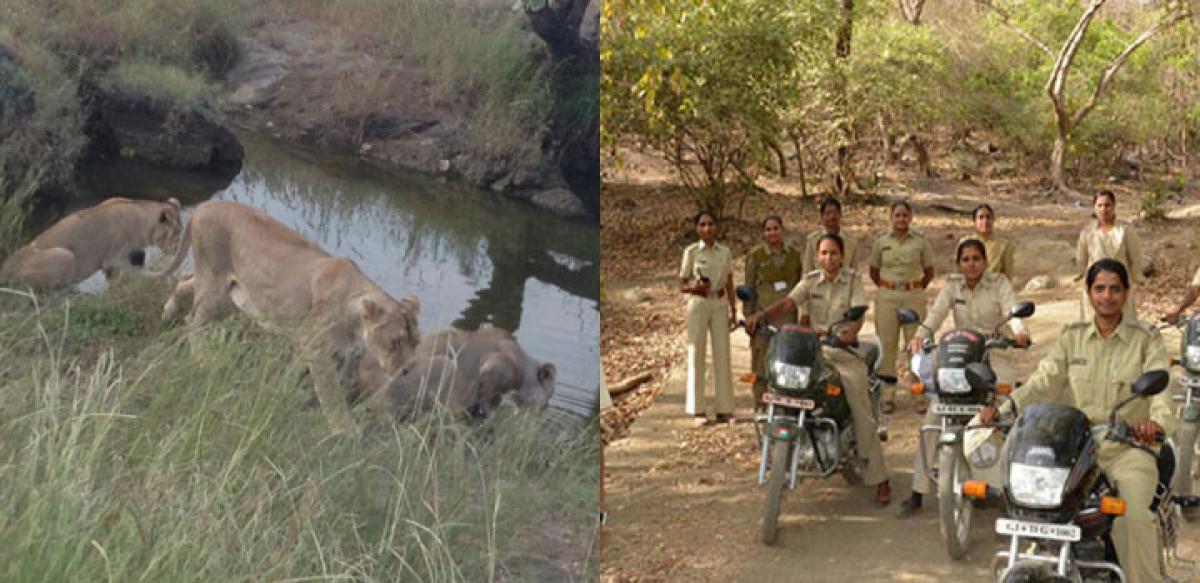Celebrating the golden Sasan Gir

The Gir Forest National Park & Wildlife Sanctuary is also known as Sasan-Gir, is a forest and wildlife sanctuary in Gujarat. It is a natural habitat for the rare species of Asiatic Lions. The sanctuary was established in 1965 and is spread over 1,412 sq km, of which about 258 sq km is fully protected the national park and other 1,154 sq km is for the sanctuary.
In September 2015, Gir Forest National Park & Wildlife Sanctuary celebrated its 50th anniversary. The sanctuary is habitat for many rare species making it one of India’s richest regions

The Gir Forest National Park & Wildlife Sanctuary is also known as Sasan-Gir, is a forest and wildlife sanctuary in Gujarat. It is a natural habitat for the rare species of Asiatic Lions. The sanctuary was established in 1965 and is spread over 1,412 sq km, of which about 258 sq km is fully protected the national park and other 1,154 sq km is for the sanctuary.
However, the total area of Gir is 2,200 sq km. Gir forest previously a well-known hunting ground of the Nawabs of Junagadh was declared as a “protected” area in 1900. It celebrated its Golden Jubilee in September 2015.
The park is located 43 km north-east of Somnath, 65 km south-east of Junagadh and 60 km south-west of Amreli and is the sole home of the majestic Asiatic lions (Panthera leo persica). It is also the location to find thousands of other uncommon creatures. The carnivores in the area comprise of Asiatic lions, Indian leopards,
Indian cobras, jungle cats, Indian palm civets, desert cats and rusty-spotted cats. The main herbivores are chital, nilgai, sambar, four-horned antelope, chinkara, wild boar and blackbucks. Among the smaller mammals is the rare pangolin. Snakes are found in abundance in the bushes and forests.
About the Golden Jubilee celebrations, Dr Sandeep Kumar, Divisional Conservation Forest, Officer of Gir, said that a two-day seminar was organised in Rajkot where a special postal stamp was launched to create awareness regarding conservation of animals.
Reporting some good news he said, “Thanks to the dedicated work by forest officers, women guards, van raksha sahayaks, veterinary care and food facilities provided, according to the 14th Asiatic Lion Census conducted in the month of May, the number of lions has increased to 523 from 174 at the sanctuary’s inception.”
He further adds that they are hopeful of crossing the figure of 1,000 by 2030. There are more than 30,000 resident animals that exist in the natural habitat, which is dominated with over 25,000 deer families.
The Gir boasts of more than 507 plant species, which includes grass and large and tall trees grown in deciduous forests that have been recorded in a recent survey. The count of distinct fauna species on the other hand has reached 2,375 and includes about 38 species of mammals, around 300 species of birds, 37 species of reptiles and more than 2,000 species of insects.
The Gujarat State Forest Department, which adopted the Indian Crocodile Conservation Project in 1977, reported that close to 1,000 marsh crocodiles reared in the Kamaleshwar Lake and other reservoirs as well as small water bodies in and around Gir.
History of Asiatic Lion in Sasan Gir:
A fascinating fact about the species of lion protected in Gir is that it is said to have been derived from just a dozen that survived in the 1880s. After the establishment of the sanctuary, the population was roughly at 70 to 200 by 1930.
However, despite the Gir forest being well protected, there are instances of Asiatic lions being poached and poisoned for attacking livestock. Some of the other threats to the species include floods, fires and the possibility of natural calamities. Most people feel lions look aggressive and are dangerous. However, the lions of Gir rarely attack people and are able to live in close proximity to people.
Celebrating the 50 years of its existence, one cannot ignore the hands that have been put together to sustain the place. The ‘Trio Lion Queens’ of Gir deserve a mention – they are three women from Saurashtra. Rasilaben Wadher, Kiran Pithiya and Darshanaben Kagada, who work as foresters at Devaliya Safari Park in Sasan Gir.
The women overcame opposition from their traditional Muslim families to work as foresters. Gir National Park and Sanctuary has been a tourist attraction for long, though it does not have a designated area for tourists to track and view their natural habitat. However, to accommodate tourist attraction, an Interpretation Zone has been created at Devalia Safari Park within the sanctuary.




















